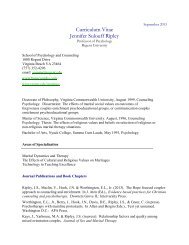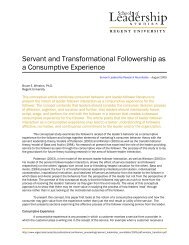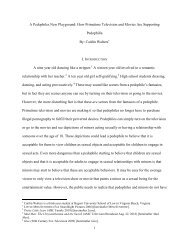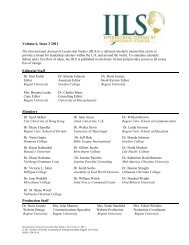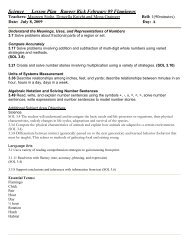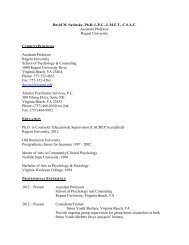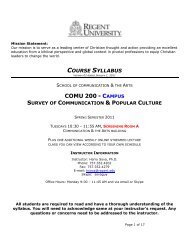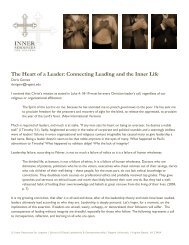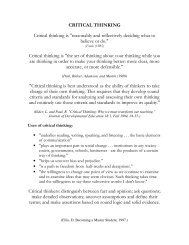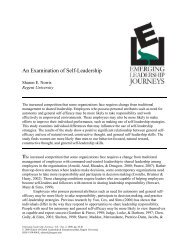Edifying the New Man: Romanian Communist ... - Regent University
Edifying the New Man: Romanian Communist ... - Regent University
Edifying the New Man: Romanian Communist ... - Regent University
Create successful ePaper yourself
Turn your PDF publications into a flip-book with our unique Google optimized e-Paper software.
Bocarnea & Osula/INTERNATIONAL JOURNAL OF LEADERSHIP STUDIES 200<br />
of history with whatever he or she has at hand to fulfill a more subtle plan. The bricoleurs make<br />
<strong>the</strong> myths and <strong>the</strong>n take <strong>the</strong>m for objective facts, trying to tack <strong>the</strong>m onto <strong>the</strong> rest of objective<br />
knowledge. The power of bricolage, to some extent, resides in its inherent creativity. The absence<br />
of a prescribed scientific path to mythmaking allows <strong>the</strong> individual mythoplast to make and<br />
unmake history and culture almost at will, deploying whatever tools are at hand. While <strong>the</strong><br />
linguistic connection between <strong>the</strong> terms mythopoeia, myopia, and utopia would make for an<br />
interesting study in what Berger and Luckmann (1966) referred to as <strong>the</strong> social construction of<br />
reality, this is outside <strong>the</strong> scope of <strong>the</strong> present paper.<br />
The Platonic mythos is a story whose truth is less vouched for and whose purpose is<br />
symbolic. Plato opposed mythos to logos, a rational and accurate story that is true and reliable.<br />
Myths are traditional stories accompanying rituals purporting to tell of occasions when some<br />
institution or cult had <strong>the</strong>ir beginning and of <strong>the</strong> original act which set <strong>the</strong> precedent for this.<br />
Myths are “obscure in origin, protean in form, and ambiguous in meaning” (Ruthven, 1976, p. 1).<br />
They are <strong>the</strong> instruments by which man struggles to make experience intelligible to himself.<br />
According to Schorer (1960), myth is a “large, controlling image that gives philosophical<br />
meaning to <strong>the</strong> facts of ordinary life; that is, which has organizing value for experience” (p. 355).<br />
In order to be accepted as myths, <strong>the</strong> works of a political elite need to be adopted by <strong>the</strong><br />
rest of <strong>the</strong> people: “Individual works are all myths potentially, but it is <strong>the</strong>ir adoption through<br />
collective use, if it occurs, which actualizes <strong>the</strong>ir mythism” (Detienne, 1981/1986, p. 47). In<br />
totalitarian regimes, <strong>the</strong> totalitarian state forces <strong>the</strong> collective adoption of its ideological opus by<br />
putting pressure on <strong>the</strong> individual, striving for <strong>the</strong> total invasion of <strong>the</strong> individual. While <strong>the</strong> state<br />
manifests itself more obviously through actions in <strong>the</strong> material realm, <strong>the</strong> spiritual invasion exists<br />
in subtler forms. Analyzing <strong>the</strong> Soviet ideology, Shlapentokh (1986) unfolded its two-level<br />
structure:<br />
The first, pragmatic level reflects <strong>the</strong> “real” material life of <strong>the</strong> people and <strong>the</strong> policy of<br />
<strong>the</strong> Soviet political leadership, while <strong>the</strong> second, mythological level consists of various<br />
myths having little in common with <strong>the</strong> “objective reality.” . . . Official mythology is <strong>the</strong><br />
main way of legitimizing <strong>the</strong> Soviet system and demands only compliance with <strong>the</strong> status<br />
quo. In its mythological activity, Soviet ideology exerts special efforts to impose <strong>the</strong><br />
secondary reality on <strong>the</strong> Soviet people. The Soviet people are suggested to live already in<br />
a world in which Soviet mythological values are implemented in life, and <strong>the</strong>y, as well as<br />
<strong>the</strong>ir leaders, behave as <strong>the</strong>se values demand. (p. 12)<br />
Shlapentokh considered such official values as <strong>the</strong> leading role of <strong>the</strong> working class,<br />
internationalism, social equality, and Socialist democracy to be part of <strong>the</strong> mythological side of<br />
<strong>the</strong> official ideology. Planning, Socialist property, patriotism, science, education, and family<br />
make up <strong>the</strong> pragmatic level of ideology.<br />
Doctrines do not become operative unless <strong>the</strong>y are capable of generating some sort of<br />
imaginative symbolism. Kertzer (1988), for instance, argued that power must be expressed<br />
through symbolic guises and, <strong>the</strong>refore, “symbolism is necessary to prop up <strong>the</strong> governing<br />
political order” (p. 174). The mythical <strong>New</strong> <strong>Man</strong> proposed by <strong>the</strong> RCP was part of its struggle of<br />
imposing <strong>the</strong> new Socialist cultural paradigm. According to Frye (1976), a myth is a “cultural<br />
model, expressing <strong>the</strong> way in which man wants to shape and reshape <strong>the</strong> civilization he himself<br />
has made” (p. 21). The <strong>New</strong> <strong>Man</strong> was <strong>the</strong> needed symbol of <strong>the</strong> emerging <strong>Romanian</strong> Socialist<br />
culture. <strong>Edifying</strong> him became an important goal of <strong>the</strong> <strong>Communist</strong> ideology. Although employed<br />
in classic analyses of capitalist relations, Lukács’ (1971) concept of reification is appropriate in<br />
this instance: “A relation between people takes on <strong>the</strong> character of a thing and thus acquires a<br />
International Journal of Leadership Studies, Vol. 3 Iss. 2, 2008, pp. 198-211<br />
©2008 School of Global Leadership & Entrepreneurship, <strong>Regent</strong> <strong>University</strong><br />
ISSN 1554-3145




